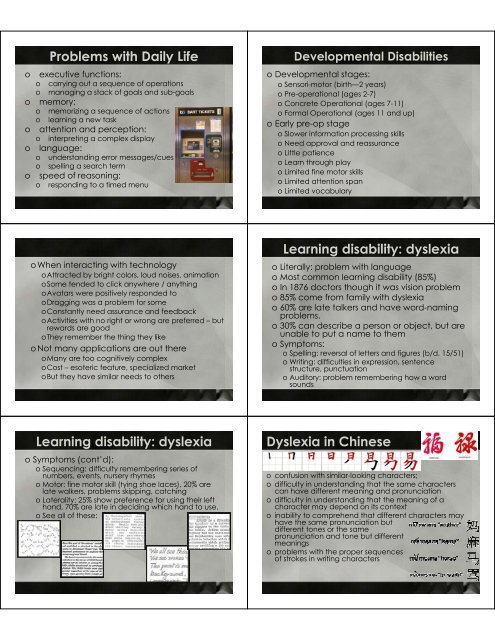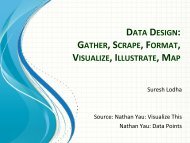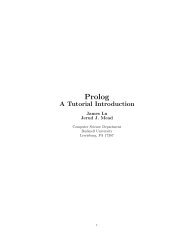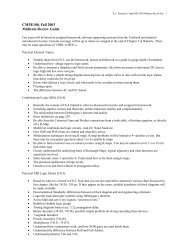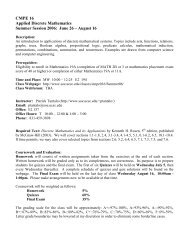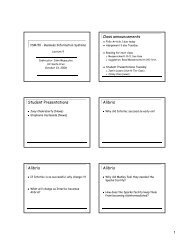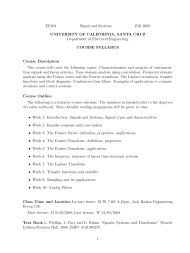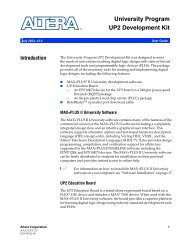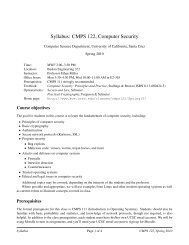Cognitive Disabilities
Cognitive Disabilities
Cognitive Disabilities
You also want an ePaper? Increase the reach of your titles
YUMPU automatically turns print PDFs into web optimized ePapers that Google loves.
Problems with Daily Life<br />
o executive functions:<br />
o carrying out a sequence of operations<br />
o managing a stack of goals and sub-goals<br />
o memory:<br />
o memorizing a sequence of actions<br />
o learning a new task<br />
o attention and perception:<br />
o interpreting a complex display<br />
o language:<br />
o understanding error messages/cues<br />
o spelling a search term<br />
o speed of reasoning:<br />
o responding to a timed menu<br />
o When interacting with technology<br />
oAttracted by bright colors, loud noises, animation<br />
oSome tended to click anywhere / anything<br />
oAvatars were positively responded to<br />
oDragging was a problem for some<br />
oConstantly need assurance and feedback<br />
oActivities with no right or wrong are preferred – but<br />
rewards are good<br />
oThey remember the thing they like<br />
o Not many applications are out there<br />
oMany are too cognitively complex<br />
oCost – esoteric feature, specialized market<br />
oBut they have similar needs to others<br />
Learning disability: dyslexia<br />
o Symptoms (cont’d):<br />
o Sequencing: difficulty remembering series of<br />
numbers, events, nursery rhymes<br />
o Motor: fine motor skill (tying shoe laces), 20% are<br />
late walkers, problems skipping, catching<br />
o Laterality: 25% show preference for using their left<br />
hand, 70% are late in deciding which hand to use.<br />
o See all of these:<br />
Developmental <strong>Disabilities</strong><br />
o Developmental stages:<br />
o Sensori-motor (birth—2 years)<br />
o Pre-operational (ages 2-7)<br />
o Concrete Operational (ages 7-11)<br />
o Formal Operational (ages 11 and up)<br />
o Early pre-op stage<br />
o Slower information processing skills<br />
o Need approval and reassurance<br />
o Little patience<br />
o Learn through play<br />
o Limited fine motor skills<br />
o Limited attention span<br />
o Limited vocabulary<br />
Learning disability: dyslexia<br />
o Literally: problem with language<br />
o Most common learning disability (85%)<br />
o In 1876 doctors though it was vision problem<br />
o 85% come from family with dyslexia<br />
o 60% are late talkers and have word-naming<br />
problems.<br />
o 30% can describe a person or object, but are<br />
unable to put a name to them<br />
oSymptoms:<br />
o Spelling: reversal of letters and figures (b/d, 15/51)<br />
o Writing: difficulties in expression, sentence<br />
structure, punctuation<br />
o Auditory: problem remembering how a word<br />
sounds<br />
Dyslexia in Chinese<br />
o confusion with similar-looking characters;<br />
o difficulty in understanding that the same characters<br />
can have different meaning and pronunciation<br />
o difficulty in understanding that the meaning of a<br />
character may depend on its context<br />
o inability to comprehend that different characters may<br />
have the same pronunciation but<br />
different tones or the same<br />
pronunciation and tone but different<br />
meanings<br />
o problems with the proper sequences<br />
of strokes in writing characters


